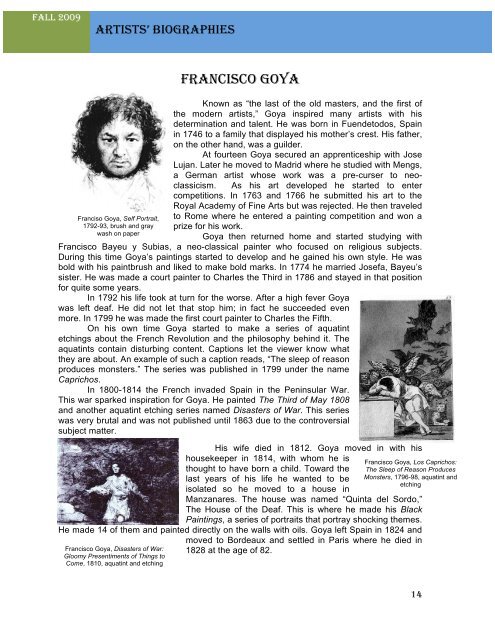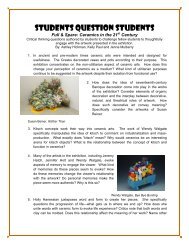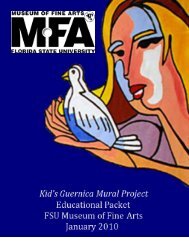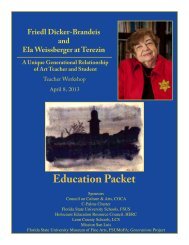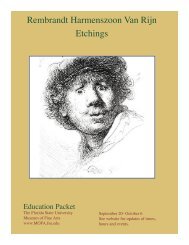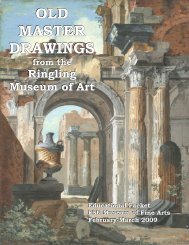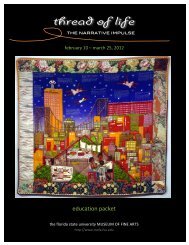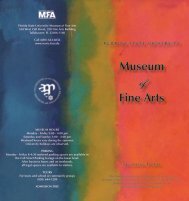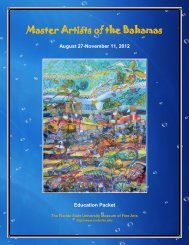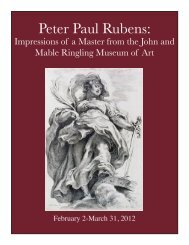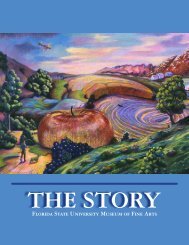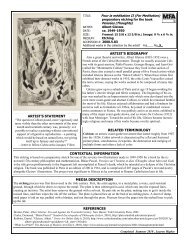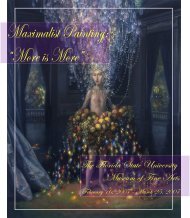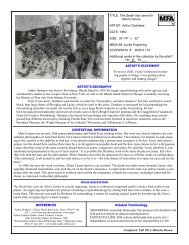Matrix: Contemporary Printmaking - Museum of Fine Arts - Florida ...
Matrix: Contemporary Printmaking - Museum of Fine Arts - Florida ...
Matrix: Contemporary Printmaking - Museum of Fine Arts - Florida ...
Create successful ePaper yourself
Turn your PDF publications into a flip-book with our unique Google optimized e-Paper software.
Fall 2009<br />
Artists’ Biographies<br />
Franciso Goya, Self Portrait,<br />
1792-93, brush and gray<br />
wash on paper<br />
Francisco Goya, Disasters <strong>of</strong> War:<br />
Gloomy Presentiments <strong>of</strong> Things to<br />
Come, 1810, aquatint and etching<br />
Francisco Goya<br />
Known as “the last <strong>of</strong> the old masters, and the first <strong>of</strong><br />
the modern artists,” Goya inspired many artists with his<br />
determination and talent. He was born in Fuendetodos, Spain<br />
in 1746 to a family that displayed his mother’s crest. His father,<br />
on the other hand, was a guilder.<br />
At fourteen Goya secured an apprenticeship with Jose<br />
Lujan. Later he moved to Madrid where he studied with Mengs,<br />
a German artist whose work was a pre-curser to neoclassicism.<br />
As his art developed he started to enter<br />
competitions. In 1763 and 1766 he submitted his art to the<br />
Royal Academy <strong>of</strong> <strong>Fine</strong> <strong>Arts</strong> but was rejected. He then traveled<br />
to Rome where he entered a painting competition and won a<br />
prize for his work.<br />
Goya then returned home and started studying with<br />
Francisco Bayeu y Subias, a neo-classical painter who focused on religious subjects.<br />
During this time Goya’s paintings started to develop and he gained his own style. He was<br />
bold with his paintbrush and liked to make bold marks. In 1774 he married Josefa, Bayeu’s<br />
sister. He was made a court painter to Charles the Third in 1786 and stayed in that position<br />
for quite some years.<br />
In 1792 his life took at turn for the worse. After a high fever Goya<br />
was left deaf. He did not let that stop him; in fact he succeeded even<br />
more. In 1799 he was made the first court painter to Charles the Fifth.<br />
On his own time Goya started to make a series <strong>of</strong> aquatint<br />
etchings about the French Revolution and the philosophy behind it. The<br />
aquatints contain disturbing content. Captions let the viewer know what<br />
they are about. An example <strong>of</strong> such a caption reads, “The sleep <strong>of</strong> reason<br />
produces monsters.” The series was published in 1799 under the name<br />
Caprichos.<br />
In 1800-1814 the French invaded Spain in the Peninsular War.<br />
This war sparked inspiration for Goya. He painted The Third <strong>of</strong> May 1808<br />
and another aquatint etching series named Disasters <strong>of</strong> War. This series<br />
was very brutal and was not published until 1863 due to the controversial<br />
subject matter.<br />
His wife died in 1812. Goya moved in with his<br />
housekeeper in 1814, with whom he is<br />
thought to have born a child. Toward the<br />
last years <strong>of</strong> his life he wanted to be<br />
isolated so he moved to a house in<br />
Francisco Goya, Los Caprichos:<br />
The Sleep <strong>of</strong> Reason Produces<br />
Monsters, 1796-98, aquatint and<br />
etching<br />
Manzanares. The house was named “Quinta del Sordo,”<br />
The House <strong>of</strong> the Deaf. This is where he made his Black<br />
Paintings, a series <strong>of</strong> portraits that portray shocking themes.<br />
He made 14 <strong>of</strong> them and painted directly on the walls with oils. Goya left Spain in 1824 and<br />
moved to Bordeaux and settled in Paris where he died in<br />
1828 at the age <strong>of</strong> 82.<br />
14


